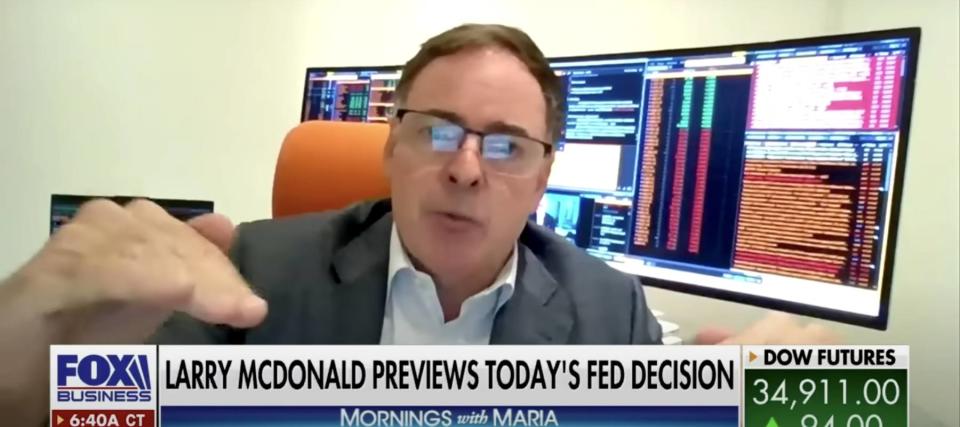Investment guru Larry McDonald warns of the 'greatest migration of capital in the history of humanity' — here's what he means and what assets he likes for cover

The Federal Reserve may be open to the possibility of hiking interest rates further, but one financial risk strategist says a slowdown of the economy and higher debt levels might cause America’s central bank to rethink its strategy.
“The Fed just mathematically can’t keep rates here that much longer,” Larry McDonald, creator of “The Bear Traps Report” investment publication, told Fox Business ahead of the Fed’s decision in late September to hold rates steady at 5.25% to 5.50%. The Fed kept rates at this level during its last meeting Oct. 31-Nov. 1, and the next rate announcement is expected mid-December.
Don't miss
Commercial real estate has outperformed the S&P 500 over 25 years. Here's how to diversify your portfolio without the headache of being a landlord
Rich young Americans have lost confidence in the stock market — and are betting on these 3 assets instead. Get in now for strong long-term tailwinds
Save big on your holiday shopping with an app that’s already saved Americans $160 million
He points to retailers like Dollar Tree and Macy’s that had been going up “in flames” as consumers pivot to essentials over discretionary goods, and predicts there could be a big debt default cycle next year if the Fed continues to raise rates.
“Your middle-class consumer is being hammered by inflation, by oil prices, by the cost of living and this softening economy,” he said.
But McDonald believes a softening economy could mean the Fed will eventually start cutting interest rates and weaken the dollar. Such a situation could be better for commodities in the long term, he says.
A turn to hard assets?
McDonald downplays trades that are “long in the tooth” or buying shares that a large number of investors own, such as in technology companies. Instead, he explains higher interest rates could drive money from the typical growth stocks of the last decade to hard assets and commodities instead.
He points to the Goldman Sachs commodity index, which he says had been outperforming the S&P 500 by nearly 10% in the previous few months.
“We’re on the precipice of the greatest migration of capital in the history of humanity,” McDonald said.
Here are three hard assets to keep an eye on.
Read more: Thanks to Jeff Bezos, you can now use $100 to cash in on prime real estate — without the headache of being a landlord. Here's how
'Sexy metals'
McDonald expressed interest what he calls “sexy metals” — such as uranium and copper — that could be used to support practical projects, like the replacement of aging power grids. He believes the U.S. will need these “strategic” commodities in the coming years, which could result in “the trade of a lifetime” for many investors.
McDonald mentioned Alcoa — one of the biggest aluminum producers in the world — as an example.
And with President Joe Biden’s big infrastructure plan to improve roads and bridges and push for energy efficiency, including electric vehicles, demand for commodities such as copper may continue to soar.
You could even consider gold, which has long been touted as a steady hedge against both inflation and deflation.
Real estate
Investing in real estate has long been recommended by experts — whether through physical property or real estate investment trusts (REITs).
Being a landlord can come with plenty of hassles, whereas REITs are publicly-traded companies that own income-producing real estate such as apartment buildings and shopping centers.
Similar to a landlord, REITs collect rent from tenants, except you get a cut in the form of dividend payments. So investors can enjoy regular income and the potential for moderate capital appreciation over the long term without actually purchasing a home and renting it out themselves.
Art
Deloitte reports an increasing demand for art among the wealthy, and estimates that ultra-high net worth individuals will have invested 2.7 trillion in collectible assets by 2026.
Perhaps less popular and more risky than real estate and gold, art is still considered a hard asset — but you actually don’t need to be an expert, or a billionaire, to start investing in it either.
For example, some companies offer fractional art investing, which allows you to buy shares in a masterpiece instead of, say, spending millions on a Banksy to put up in your living room.
Just bear in mind that while fine art can boast impressive returns, nothing is guaranteed and returns can vary depending on the style of art and the individual piece.
What to read next
Worried about the economy? Here are the best shock-proof assets for your portfolio. (They’re all outside of the stock market.)
Here's how much the typical baby boomer has saved for retirement — how do you stack up right now?
'A natural way to diversify': Janet Yellen now says Americans should expect a decline in the USD as the world's reserve currency — 3 ways you can prepare
This article provides information only and should not be construed as advice. It is provided without warranty of any kind.

 Yahoo Finance
Yahoo Finance 